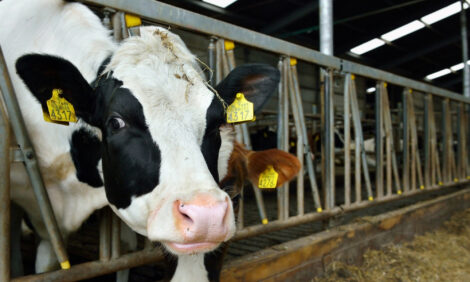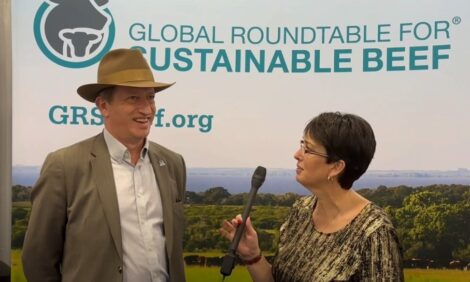



USMEF conference opens with focus on differentiation, long-term investment
Job #1 is to showcase the quality and consistency of US beef, pork and lambEmphasizing the quality and consistency of US red meat is the key to expanding the international customer base, according to the impressive lineup of opening day speakers on Wednesday at the US Meat Export Federation (USMEF) Spring Conference held in Kansas City, Missouri in late May. USMEF members from throughout the nation also learned about additional resources available to promote US pork, beef and lamb in emerging markets through USDA’s new Regional Agricultural Promotion Program (RAPP).
USMEF Chair Randy Spronk, a pork and grain producer from Edgerton, Minn., welcomed attendees with a reminder of how critical free trade agreements (FTAs) have been in creating global opportunities for the US red meat industry.
“Would we have found success in South Korea if US beef was still tariffed at 40% and US pork at 25%?” Spronk asked. “Would we have been able to develop Central and South America, or the Dominican Republic, into reliable destinations for US red meat?"
While they are not full-blown FTAs, Spronk also praised the market access gains achieved in the US-China Phase One Economic and Trade Agreement and the US-Japan Agreement.
“With the weak yen and other headwinds in Japan, imagine trying to compete effectively there if US beef and pork were still at a tariff disadvantage,” Spronk noted.
USMEF President and CEO Dan Halstrom followed with an update on year-to-date export results for US pork, beef and lamb. On the pork side, Halstrom explained that while shipments to leading market Mexico are on a record pace, US pork is achieving broad-based growth in several regions. Halstrom noted that first quarter export value ($2.1 billion) equated to more than $64 per hog slaughtered, while March exports averaged nearly $71 per head.
March was also a great month for US beef export value, which equated to nearly $455 per head of fed slaughter. The first quarter average was $408, up 9% from a year ago, which Halstrom said was a very encouraging metric.
“This tells me that the global consumer is willing to pay because they understand the value of US beef,” Halstrom said. “We’re different. We’re higher value, higher perception. US beef is not a commodity product, like a lot of our competitors. This is a key takeaway.”
Guest speaker Randy Blach, CEO of CattleFax, echoed these sentiments in explaining how US beef competes for the consumer dollar, both in the US and internationally.
“The biggest change in the beef industry has been quality,” Blach said. “And we can never lose sight of that – our niche is grain-fed, high-quality beef that really nobody else can produce around the globe. Those of you who are producers in the room, you have also invested in genetics and you have gotten paid dividends for those decisions.”
Blach also gave an update on the US cattle industry’s herd rebuilding efforts. He noted that the US herd is not yet in expansion mode, but liquidation has definitely slowed, and the herd size has stabilized. He cautioned that even when expansion does materialize, it will not mirror the previous expansion cycle.
“The cost of money is significantly different, and there’s a worry hanging over people’s heads about going back into a La Niña [weather pattern],” Blach said. “The last cattle cycle saw the most rapid expansion in the history of our industry in 2014 and 2015. This time I think we’ll get some expansion, but it's going to stretch out over a longer period of time.”
As for expanding exports, Blach stressed the need for patience and persistence in developing new markets.
“During my career at CattleFax, I have seen how USMEF is able to go into these markets and build a foundation,” he explained. “Japan didn't just become our biggest market overnight, did they? It took decades to build that market, to build confidence and to build relationships. This is not instant gratification that you're talking about. You need to have a vision of the decisions you're making today, and know that we may not see the fruit of those decisions until five or 10 years down the road.”
Daniel Whitley, administrator of USDA’s Foreign Agricultural Service, praised USMEF members for their productivity gains while also providing an update on RAPP funding allocations. He highlighted RAPP’s goal of helping US exporters expand their customer base beyond traditional and established markets, focusing on regions such as Africa, Latin America and Southeast Asia.
Whitley noted that RAPP places a specific emphasis on Africa, which is projected to hold 25% of the world’s population by 2050. That same year, the planet’s total population is expected to reach 10 billion, which presents a massive food production challenge.
“There is no way – no way – that the global agricultural community will be able to solve the problem of feeding 10 billion people by the year 2050 if we don't embrace science, technology and innovation,” Whitley said. “All of the wonderful seed techniques, all of the wonderful techniques we use to grow livestock and farm animal products, we need all of these techniques. We're not going to find new land and plant our way out of this problem, so there's really only one path forward and I do think it's the embrace of science, technology and innovation.”
USMEF members also received unique insights about global food security issues from Kip Tom, former US ambassador to the United Nations for Food and Agriculture. Ambassador Tom stressed that our national security is dependent on our food security, and he too emphasized the need to embrace production technologies.
“The innovation that has taken place in agriculture, whether it's on the livestock side, or the grain side, or food processing – it’s something we need to be very proud of,” Tom said. “We oftentimes say that the US innovates, China replicates and the EU regulates. But we need to make sure we keep those in check, so that we can continue to innovate, grow our economy and grow this industry.”
While Tom believes the US must pay close attention to the global trade advances made by major agricultural competitors, he shares the opinion that an emphasis on quality will differentiate US products and lead to continuing opportunities for American agriculture.
“When I look at Brazil, for example, and what they're exporting in terms of animal proteins, what they're doing in terms of exporting grains, the reality is, they're mostly exporting commodities,” said Tom. “And this is where the real opportunity is for US agriculture – to make sure that we add value and ensure that we set ourselves apart in the global marketplace, to maintain and grow our markets.”
The USMEF Spring Conference continued through Friday, May 24. Thursday’s program feature a panel discussion on consumer perceptions of red meat products, as well as meetings of USMEF’s sector-specific standing committees. Friday’s general session focused on the organization’s efforts to build global demand for underutilized beef and pork cuts.


